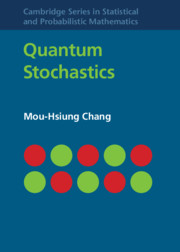Book contents
- Frontmatter
- Dedication
- Contents
- Preface
- Introduction and Summary
- 1 Operator Algebras and Topologies
- 2 Quantum Probability
- 3 Quantum Stochastic Calculus
- 4 Quantum Stochastic Differential Equations
- 5 Quantum Markov Semigroups
- 6 Minimal QDS
- 7 Quantum Markov Processes
- 8 Strong Quantum Markov Processes
- 9 Invariant Normal States
- 10 Recurrence and Transience
- 11 Ergodic Theory
- Bibliography
- Index
3 - Quantum Stochastic Calculus
Published online by Cambridge University Press: 05 February 2015
- Frontmatter
- Dedication
- Contents
- Preface
- Introduction and Summary
- 1 Operator Algebras and Topologies
- 2 Quantum Probability
- 3 Quantum Stochastic Calculus
- 4 Quantum Stochastic Differential Equations
- 5 Quantum Markov Semigroups
- 6 Minimal QDS
- 7 Quantum Markov Processes
- 8 Strong Quantum Markov Processes
- 9 Invariant Normal States
- 10 Recurrence and Transience
- 11 Ergodic Theory
- Bibliography
- Index
Summary
This chapter begins with introductions of symmetric Fock space Γ(ℍ) and symmetric Guichardet space Φ(ℍ) of a generic complex Hilbert space ℍ. It is shown that these 2 spaces are actually isomorphic and can and will be used interchangeably throughout the chapter. In particular, the simple and yet useful integral-summation formula (see Theorem (3.2.1)) for the Guichardet space is often employed to establish the essential results in quantum stochastic calculus. It has been shown that the symmetric Fock space (and hence the symmetric Guichadet space) provides a plausible mathematical tool for modeling phenomena in quantum optics or quantum electrodynamics. Many results in the quantum physics and quantum probability literature are actually established based on this concrete model space. When the generic complex Hilbert space ℍ = L2(ℝ+; K) (where K is another complex Hilbert space), the class of exponential vectors along with 3 different types of quantum noise processes, namely, the creation, annihilation, and neutral (or guage) processes, can be introduced. It is shown that the subspace generated by the class of exponential vectors is dense in the Fock space. Therefore, it is convenient to verify the properties that hold for Fock space by verifying the same hold for the class of exponential vectors. Parallel to those of Itô integrals with respect to classical Brownian motion and/or Poisson process, the concepts of a quantum stochastic integral of a operator-valued process (as a member of the Fock space) with respect to each of the above mentioned quantum noise processes are constructed. The quantum stochastic calculus, parallel to those of classical Itô calculus, is developed.
The theory of quantum stochastic calculus on the symmetric Fock space due originally to Hudson and Parthasarathy [HP84a] has been the topic of investigation by many researchers in the last 20 years. Much of he material presented in this chapter can be found in the books by Meyer [Mey95], Parthasarathy [Par92] and Attal [Att03].
- Type
- Chapter
- Information
- Quantum Stochastics , pp. 81 - 118Publisher: Cambridge University PressPrint publication year: 2015



